Related Research Articles
In Norse mythology, Árvakr and Alsviðr are the horses which pull the sun, or Sól's chariot, across the sky each day. It is said that the gods fixed bellows underneath the two horses' shoulders to help cool them off as they rode.
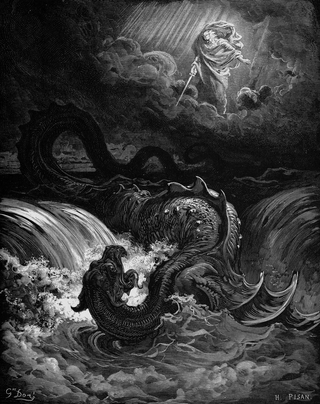
The Leviathan is a sea serpent noted in theology and mythology. It is referenced in several books of the Hebrew Bible, including Psalms, the Book of Job, the Book of Isaiah, and the pseudepigraphical Book of Enoch. The Leviathan is often an embodiment of chaos and threatening to eat the damned after their life. In the end, it is annihilated. Christian theologians identified Leviathan with the demon of the deadly sin envy. According to Ophite diagrams, the Leviathan encapsulates the space of the material world.
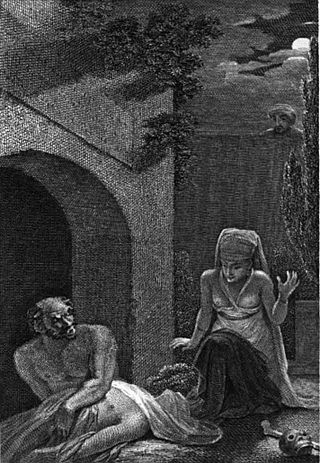
A ghoul is a demon-like being or monstrous humanoid, often associated with graveyards and the consumption of human flesh. The concept originated in pre-Islamic Arabian religion. Modern fiction often uses the term to label a specific kind of monster.

An elemental is a mythic supernatural being that is described in occult and alchemical works from around the time of the European Renaissance, and particularly elaborated in the 16th century works of Paracelsus. According to Paracelsus and his subsequent followers, there are four categories of elementals, which are gnomes, undines, sylphs, and salamanders. These correspond to the four Empedoclean elements of antiquity: earth, water, air, and fire, respectively. Terms employed for beings associated with alchemical elements vary by source and gloss.

The wild man, wild man of the woods, or woodwose/wodewose is a mythical figure and motif that appears in the art and literature of medieval Europe, comparable to the satyr or faun type in classical mythology and to Silvanus, the Roman god of the woodlands.

Myomancy is the practice of reading omens from the behavior of rats or mice, a "theriomantic" method of divination which might be implied in the Bible verse Isaiah 66:17.
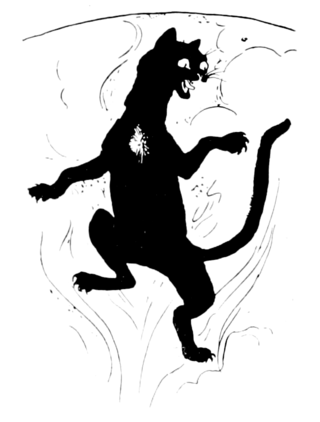
The cat-sìth, in Irish cat sí, is a fairy creature from Celtic mythology, said to resemble a large black cat with a white spot on its chest. Legend has it that the spectral cat haunts the Scottish Highlands. The legends surrounding this creature are more common in Scottish folklore, but a few occur in Irish. Some common folklore suggested that the cat-sìth was not a fairy, but a witch that could transform into a cat nine times.
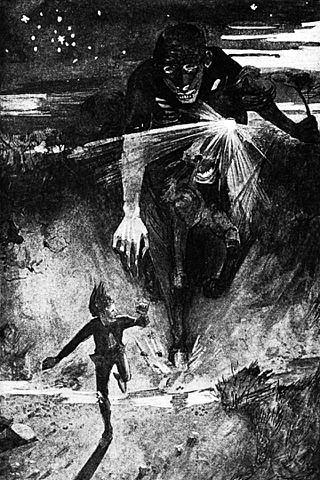
The nuckelavee or nuckalavee is a horse-like demon from Orcadian folklore that combines equine and human elements. British folklorist Katharine Briggs called it "the nastiest" of all the demons of Scotland's Northern Isles. The nuckelavee's breath was thought to wilt crops and sicken livestock, and the creature was held responsible for droughts and epidemics on land despite being predominantly a sea-dweller.

Heinrich Khunrath, or Dr. Henricus Khunrath as he was also called, was a German physician, hermetic philosopher, and alchemist. Frances Yates considered him to be a link between the philosophy of John Dee and Rosicrucianism. His name, in the spelling "Henricus Künraht" was used as a pseudonym for the 1670 publisher of the Tractatus Theologico-Politicus of Baruch Spinoza.

The Kellas cat is a large black cat found in Scotland. It is an interspecific hybrid between the Scottish wildcat and the domestic cat. Once thought to be a mythological wild cat, with its few sightings dismissed as hoaxes, a specimen was killed in a snare by a gamekeeper in 1984 and found to be a hybrid between the Scottish wildcat and domestic cat. It is not a formal cat breed, but a landrace of felid hybrids. It is named after the village of Kellas, Moray, where it was first found. The purported first live cat was caught by the Tomorrows World team and featured in the 1986 programme 'On the Trail of the Big Cat'. The historian Charles Thomas speculated that the Pictish stone at Golspie may depict a Kellas cat. The Golspie stone, now held at the Dunrobin Castle Museum, shows a cat-like creature standing on top of a salmon which may allude to the characteristics ascribed to a Kellas cat of catching fish while swimming in the river.
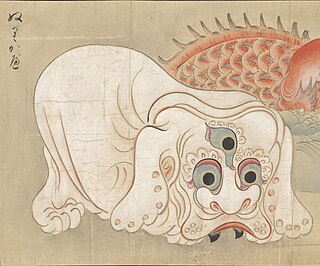
The nurikabe is a yōkai, or spirit, from Japanese folklore. Its name translates to "plaster wall", and it is said to manifest as an invisible wall that impedes or misdirects travelers walking at night. Sometimes referred to in English as "The Wall" or "Mr. Wall", this yōkai is described as quite tall, to prevent people from climbing over it, and wide enough to dampen any attempts to go around it. Japanese scholar and folklorist Kunio Yanagita recorded perhaps the most prominent early example of nurikabe and other yōkai in his books. Manga artist Shigeru Mizuki claims to have encountered a nurikabe in New Guinea, inspiring a nurikabe character in his manga Gegege no Kitarō.

An Encyclopaedia of New Zealand is an official encyclopaedia about New Zealand, published in three volumes by the New Zealand Government in 1966. Edited by Alexander Hare McLintock, the parliamentary historian, assisted by two others, the encyclopaedia included over 1,800 articles and 900 biographies, written by 359 contributing authors.

Gamayun is a prophetic bird of Russian folklore. It is a symbol of wisdom and knowledge and lives on an island in the mythical east, close to paradise. She is said to spread divine messages and prophecies, as she knows everything of all creation, gods, heroes, and man. Like the Sirin and the Alkonost, other creatures likewise deriving ultimately from the Greek myths and siren mythology, the Gamayun is normally depicted as a large bird with a woman's head. In the books of the 17th-19th centuries, Gamayun was described as a legless and wingless bird, ever-flying with the help of a tail, foreshadowing the death of statesmen by her fall.
The glawackus is one of the fearsome critters, a group of legendary creatures in the folklore and traditions of lumberjacks during the 19th and early 20th centuries in North America. The glawackus is described as looking something between a bear, a panther, and a lion. The glawackus is also known as the northern devil cat. It is known for its fearsome screech that compares to the cackle of a hyena. The creature is blind and uses its sense of smell as well as sound waves. Looking into the creature's eyes is said to wipe the victim's memory. It was seen in 1939 in Glastonbury, Connecticut.
A legendary creature from Welsh tradition depicted as very large and intelligent birds, often considered to be related to the griffin,

The Rompo is a mythological beast said to have been found in India and Africa. It is described as having the head and mouth of a hare, the ears of a human, a mane, a slender body approximately three feet in length, a long tail ending in a hairy brush, the front feet of a badger, and the rear feet of a bear. It feeds on human corpses, which it obtains by digging up graves, and is termed the "Man-Eater" due to this habit. After discovering a body, instead of immediately devouring it, it circles around it several times as if afraid to seize it. The legend of the Rompo may have been inspired by the ecology and behavior of hyenas.
An orc, in J. R. R. Tolkien's Middle-earth fantasy fiction, is a race of humanoid monsters, which he also calls "goblin".
A ghoul is a mythical creature originating in pre-Islamic Arabia, often described as hideous human-like monster that dwelt in the desert or other secluded locations in order to lure travellers astray. It was not until Antoine Galland translated the Arabian Nights into French that the western idea of ghoul was introduced. Galland depicted the ghoul as a monstrous creature that dwelled in cemeteries, feasting upon corpses. This definition of the ghoul has persisted until modern times, with ghouls appearing in literature, television and film, as well video games.

Ababil means a "Flock of Birds". It refers to the miraculous birds in Islamic belief mentioned in Surah Al-Fil of the Quran that protected the Kaaba in Mecca from the Aksumite elephant army of Abraha, then self-styled governor of Himyar, by dropping small clay stones on them as they approached. In the translation of sahih international, the phrase "tayran abābīl(a)"(طَيْرًا أَبَابِيلَ) is translated as "Birds in flocks" that is mentioned in the verse 105:3.
In Scottish folklore, the beithir is a large snakelike creature or dragon.
References
- ↑ Giants, Monsters, and Dragons: An Encyclopedia of Folklore, Legend, and Myth by Carol Rose page 4
- 1 2 Matthews, John and Caitlin (2005). The Element Encyclopedia of Magical Creatures. HarperElement. p. 8. ISBN 978-1-4351-1086-1.